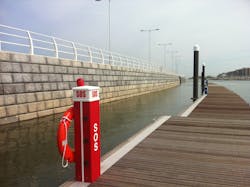Iconic pedestrian bridge opens in Wales
In 2004, the City of Rhyl began plans to transform its riverfront. Construction began in 2012 to turn what was formerly an unusable riverfront into a beautiful gathering place for the town. Complete with a new cycle and pedestrian bridge, this project now provides a safer route for the bike path that follows the entire coastline of Wales. To make the bridge a reality, the City first needed to reinforce and deepen the river channel, plus create space near the bridge for a new public square.
In the spring of 2012, a massive construction project began in Rhyl, North Wales. The goal of the project was to transform Rhyl’s riverfront area to increase tourism and boost the local economy. Another key goal was to provide a safer, more scenic route for pedestrians and cyclists using the Wales Coast Path, which follows the entire coastline of Wales.
To accomplish all of this, the site first required an aesthetic retaining-wall solution that could meet the complex structural requirements of the site, including significant tidal fluctuations.
Initially, designers considered conventional wall solutions such as cladded sheet piles to reinforce the banks and prepare for bridge construction, but this solution was too cost-prohibitive.
Searching for a wall solution that would match the visual scale and structural requirements, local officials turned to CPM Group. Designers were able to provide an aesthetic Limestone finish with the Redi-Rock Positive Connection System at a lesser cost than other options.
The system is a mechanically stabilized earth retaining wall system that utilizes 1520-lb precast blocks and a corrosion-free reinforcement system without special connection components. Unlike friction connections featured in other geosynthetic-reinforced wall systems, there is virtually no chance of a pullout connection failure with the PC system because the grid wraps through the block. Because the PC system’s reinforcement is non-corrosive, it is a great fit for projects like this that are exposed to salt water. Although multiple PC system walls have been installed in the U.S., this was the first PC system wall in the UK.
At its tallest point, the wall needed to stand 24.3 ft high and was designed based on the 100-year extreme water level and a 6.6-ft tidal lag.
The Redi-Rock blocks were installed on a concrete foundation in 164-ft sections. When a course of blocks was in place, installers threaded Miragrid 10 XT, 20 XT or 24 XT through the blocks. The layers of backfill material were then placed and the geogrid pulled into position before the next course of blocks was installed.
To prevent scour, 9.8- to 13.1-ft-long steel sheet piles were installed in front of the wall. In addition, a reinforced concrete coping was cast in-situ which tied the top course of blocks to the lower course and also created a beam along the wall.
Using the PC system allowed the contractor to install approximately 50 blocks during a tidal cycle, and installation of the entire quay wall was completed in just 30 weeks.
Next came the bridge installation. “The iconic bridge structure provides a single leaf bascule opening span over the navigable channel, giving unlimited clearance,” explained the general contractor, Dawnus Construction. “To balance the lift, the back span also lifts mirroring its twin. A single Duplex stainless steel mast nearly 164 ft tall houses a pulley mechanism and associated lift cables, providing a visual declaration of the bridge's presence that will be visible from miles around and also will provide a central focus within the harbor. To accommodate the central mast, each deck splits to permit a 9.84 ft walkway on either side.”
The bridge opened in October 2013 and officials are very pleased with how the project turned out.
